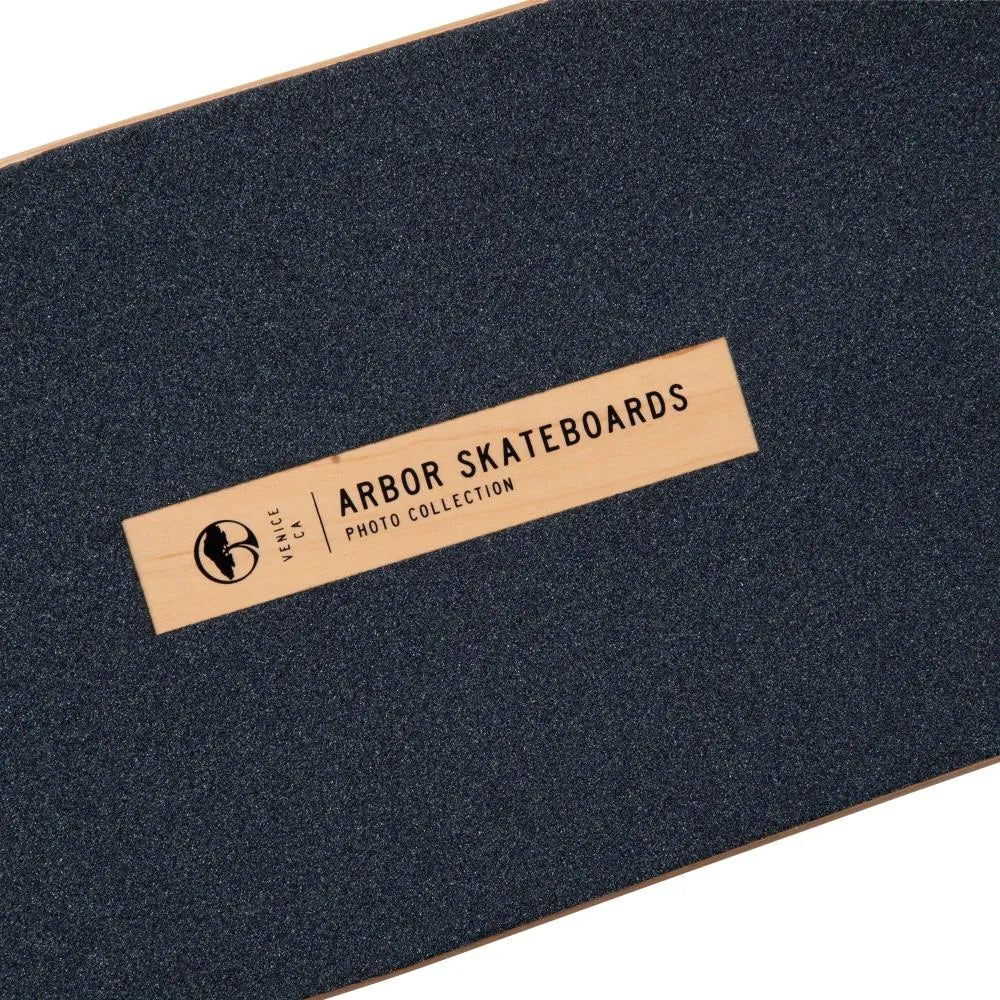Arbor Cruiser Complete Photo Axis 37 Longboard Skateboard
Arbor Cruiser Complete Photo Axis 37 Longboard Skateboard
In stock
Couldn't load pickup availability
Arbor Cruiser Complete Photo Axis 37 Longboard Skateboard
A snowboard-inspired drop-through Longboard Skateboard for easy around town cruising, relaxed commutes, and mellow downhill. Photographer: Michael Townsend.
- L: 37.00"
- W: 8.50"
- WB: 27.75"
MATERIALS & COMPONENTS
DECK
- 8 ply Canadian Hardrock Maple
- Wood material comes from sustainable sources of supply
- Wood by-product is reclaimed for use in other products
TRUCKS
- Paris Reverse 50° 180mm
WHEELS
- Arbor Easyrider Series - Outlook
- Longboard Skateboard Designed for carving and cruising
- Larger shape increases rolling speed
- Size: 69mm // Durometer: 78A
- Contact Patch: 44.0mm // Offset: 0.0mm
- Momentum Core: Dampens bumpy rides
- Venice Formula: Soft and grippy
OTHER COMPONENTS
- ABEC 5 Bearings with Spacers
- Die-Cut Griptape
- Size: 37 x 8.5 IN
Check out our full longboard skateboard range here
History of the longboard skateboard
The longboard skateboard has a rich and evolving history. It traces its roots to the surf culture of the 1950s. Surfers in Hawaii first created boards to surf on land. They mounted roller skate wheels onto wooden planks. These early designs were crude but functional.
As skateboarding grew, longboards developed alongside shortboards. In the 1970s, the urethane wheel was invented. This changed everything. It provided better grip and smoother rides. Riders could carve turns like they did on waves. Longboards gained popularity among surfers and downhill enthusiasts.
The 1990s saw a major resurgence in longboarding. Companies began designing boards specifically for downhill and cruising. Skaters wanted smoother rides and faster speeds. The boards evolved with longer decks and more flexible materials. This allowed for better carving, stability, and speed control.
Today, there are many types of longboard skateboard. Each type serves a different riding style or purpose. The most common categories are cruising, carving, downhill, freestyle, and dancing. Cruising boards are designed for easy transportation. They usually have soft wheels and a flexible deck. These are great for beginners and casual riders.
Carving boards are similar but focus more on deep turns. They often have drop-through decks for added stability. Drop-through decks allow the trucks to mount through the deck. This lowers the rider’s center of gravity, improving control. Carving boards usually feature responsive trucks for tight turns.
Downhill boards are built for speed. They prioritize stability over maneuverability. These boards often have stiff decks to reduce flex. A stiff deck gives more control at high speeds. Most downhill setups also include precision trucks. These provide tighter turning radii and less wobble.
Freestyle boards are meant for tricks and stunts. These longboards are more versatile and often symmetrical. They feature kicktails on both ends. This allows for manual tricks and flips. Freestyle riders need lightweight, balanced setups. These boards usually have medium flex for comfort and response.
Dancing boards are designed for flow and movement. They are longer than average, often over 45 inches. This extra length provides space to walk or spin on the deck. Dancing boards are usually flexible and feature twin tips. The trucks are set wider apart for added stability.
Deck shapes also vary between styles. Pintail decks are narrow and surf-inspired. They prevent wheel bite and are popular for cruising. Drop decks are lower to the ground. This design is common in downhill and commuting setups. It improves pushing efficiency and ride comfort.
Trucks play a key role in longboard performance. There are two main types: traditional kingpin (TKP) and reverse kingpin (RKP). TKP trucks are compact and reactive. They are mostly used in freestyle or park setups. RKP trucks are taller and more stable. These are favored for cruising, carving, and downhill.
Truck width must match deck width. A balanced setup improves ride control and safety. Wider trucks give more stability. Narrower trucks offer quicker turning. Bushings also affect truck performance. Softer bushings allow easier turns. Harder bushings provide more resistance and stability.
Longboard setups are highly customizable. Riders can change wheels, bearings, bushings, and deck flex. This allows them to fine-tune their board for different terrains and styles. Wheels vary in hardness, size, and shape. Larger, softer wheels absorb more shock. They are ideal for rough surfaces and high-speed riding.
Overall, the longboard has grown into a specialized tool. Its evolution reflects changes in skate culture and rider needs. From surfing sidewalks to bombing hills, longboards continue to innovate. Each setup offers a unique ride, tailored to its user. The longboard remains a symbol of freedom, creativity, and motion.
Share














